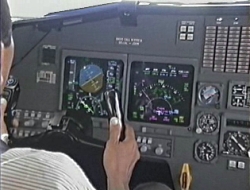A mission for Super Flight Attendants.
FAA's Determination and Requirements of This AD
FAA Airworthiness Directive
Since the unsafe condition described is likely to exist or develop on other airplanes of the same type design, we issued AD 2011-04-09 to eliminate a hazard with chemical oxygen generators in the lavatory, which, if not corrected, could jeopardize flight safety. The AD requires either activating all chemical oxygen generators in the lavatories until the generator oxygen supply is expended, or removing the oxygen generator(s); and, for each chemical oxygen generator, after the generator is expended (or removed), removing or re-stowing the oxygen masks and closing the mask dispenser door.
We have determined that notice and opportunity for prior public comment on AD 2011-04-09 were contrary to the public interest, and good cause existed to make the AD effective immediately by individual notices issued on February 10, 2011, to the known U.S. owners and operators of certain passenger-carrying transport category airplanes operating in 14 CFR part 121 air carrier service; or U.S.-registered and operating under 14 CFR part 129, with a maximum passenger capacity of 20 or greater; and equipped with any chemical oxygen generator installed in any lavatory.
These conditions still exist, and the AD is hereby published in the Federal Register as an amendment to section 39.13 of the Federal Aviation Regulations (14 CFR 39.13) to make it effective to all persons.
The FAA says it will take comments until April 22 on an airworthiness directive (PDF) that was issued in secret on Feb. 10 to all U.S. airlines with airplanes that have bathrooms. The existence of the AD, which required the airlines to disable the chemical oxygen generators that create oxygen for decompression masks in the lavs, was made public last week after all those who got the February notice had confirmed their compliance with it. About 6,000 aircraft were affected. The agency said in the AD that the systems could "jeopardize flight safety" and that it was in the public interest to have the work done quietly. The FAA didn't say specifically what the hazard is but there are various reports that suggest the action was taken to prevent would-be terrorists from going behind closed doors to turn the bathroom oxygen generators, which are identical to those in the main cabin, into something capable of bringing the aircraft down.
Oxygen Generator Deactivation
(g) Within 21 days after the effective date of this AD, do the actions specified in paragraphs
(g)(1) and (g)(2) of this AD.
(1) Activate all chemical oxygen generators in the lavatories until the generator oxygen supply is expended. An operator may also remove the oxygen generator(s), in accordance with existing maintenance practice, in lieu of activating it.
(2) For each chemical oxygen generator, after the generator is expended (or removed), remove or re-stow the oxygen masks and close the mask dispenser door.
Note 1: Chemical oxygen generators are considered a hazardous material and subject to specific requirements under Title 49 CFR for shipping. Oxygen generators must be expended prior to disposal but are considered a hazardous waste; therefore, disposal must be in accordance with all Federal, State, and local regulations. Expended oxygen generators are forbidden in air transportation as cargo.
For more information, contact 1-800-HMR-4922.
ADDRESSES: You may send comments by any of the following methods:
- Federal eRulemaking Portal: Go to http://www.regulations.gov. Follow the instructions for submitting comments.
- Fax: 202-493-2251.
- Mail: U.S. Department of Transportation, Docket Operations, M-30, West Building Ground Floor, Room W12-140, 1200 New Jersey Avenue, SE., Washington, DC 20590.
- Hand Delivery: U.S. Department of Transportation, Docket Operations, M-30, West Building Ground Floor, Room W12-140, 1200 New Jersey Avenue, SE., Washington, DC 20590, between 9 a.m. and 5 p.m., Monday through Friday, except Federal holidays.
Lavatories' Oxigen Mask Removal.
After rapid decompression the crew should push the aircraft nose down and likely turning away flight route.
Take a look in this image above to understand outside aircraft view on rapid descent.
The fixed oxygen system in the cabin supplies oxygen to the occupants in case of cabin depressurization.
Chemical generators produce the oxygen. Each generator feeds a group of 2, 3, or 4 masks. Generators and masks are in containers above the passenger seats, in the lavatories, in each galley and at each cabin crew station.
OPERATION
Each container has an electrical latching mechanism that opens automatically to allow the masks to drop if the cabin pressure altitude exceeds 14000 feet (+ 0, - 500 feet). Members of the flight crew can override the automatic control.
When the masks are released, the passenger address system automatically broadcasts prerecorded instructions (if installed) for using them.
The generation of oxygen begins when the passenger pulls the mask toward the passenger seat. The chemical reaction used for oxygen generation creates heat. Therefore, smell of burning, smokes and cabin temperature increase may be associated with the normal operation of the oxygen generators. The mask receives pure oxygen under positive pressure for about 22 minutes, until the generator is exhausted.
A reset is available for the rearming of the system after the masks are restowed. A manual release tool allows crew members to open the doors manually in case of electrical failure.
OPERAÇÃO (A330)
Os compartimentos de cada unidade abrem:
- As máscaras de oxigênio caem e ficam penduradas por cordas.
- O usuário puxa uma das máscaras em direção ao rosto.
(As cordas puxam o pino de liberação do conjunto do disparador do gerador).
- O disparador atinge o pino de percussão e o fornecimento de oxigênio é gerado.
- O oxigênio flui pelas mangueiras flexíveis de fornecimento até o reservatório.
- O indicador do fluxo é a parte verde do resrvatório. Ele infla quando o oxigênio está fluindo.
- O gerador químico de oxigênio fornece um fluxo de oxigênio de baixa pressão por no mínimo 22 minutos.
CUIDADO: UMA VEZ ATIVADO, O GERADOR NÃO PODER SER DESLIGADO
NOTA: Depois da queda de emergência das máscaras, será apropiado fazer um anúncio aos passageiros, explicando a possibilidade de um cheiro de queimado na cabine, associado com a operação normal do sistema do gerador de oxigênio.
Let's calculate the descent after rapid decompression.
We are flying at Flight Level 39000 feet.
A rapid decompression will force the crew to start descent for a flight level in which human being can breathe normally. It’ll be below 14000 feet, so our aircraft should be set for a descent rate of 6000 feet per minute (Maximum Rate of Descent). The airplane will have lost 27000 feet at flight level 12000 feet. We will level off on that altitude after 4.5 minutes.
Now you think about those passengers seated on last seats near the aircraft tail, they will feel their bodies slipping forward because of plane’s angle of attack. Pitch down, like a car descending an abrupt slope.
He/She should hold the oxygen mask on his/her nose for breathing oxygen during 4.5 minutes, otherwise he/she will die before the aircraft has reached 12000 feet.
Now let’s think about a flight attendant trying to walk slope up inside the plane (or slope down) toward any lavatory to help someone inside it.
Very likely all flight attendants will hover the passenger seats.
Someone will be hurt, inside the lavatory or on passenger cabin.









Nenhum comentário:
Postar um comentário